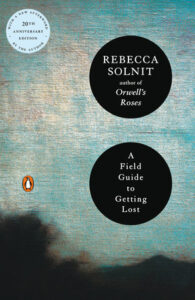One of the great joyful mysteries of writing comes when work whose creation arose from the writer’s innermost desires somehow meets those of its readers. I let this book loose in the world with no assumptions about if and how it would be received, after writing it in a state of profound uncertainty about what I was doing.
Article continues after advertisement
The process of writing this one was inseparable from its overarching theme. I didn’t know if I would ever complete it, and if I did if I’d ever want to show it to anyone. Then, when it was a five-chapter manuscript, I showed it to my agent, and she showed it to my editor at Viking, Paul Slovak, who wanted to publish it. But it was too short, and since it already had a beginning and an ending and could not grow, in my view, in either direction, I decided to interleave the existing chapters with the four “Blue of Distance” chapters.
A number of things had led to the writing of this book. One was that my earlier book with Paul, Wanderlust: A History of Walking, had touched on meandering and being out in the world willing to encounter the unknown and the unpredictable, but it felt like there was far more to explore about this theme (especially since we were entering an era, even then, of more digital aids to navigation and more reluctance to wing it).
Another was that I had been writing books governed by what I could call the rules of daylight—narratives organized by chronology, analysis, argument, data drawn from research—and I wanted to write by the rules of night, by association and intuition, the kind of freedom that I associate most with poetry. Poetry performs and encourages leaps, asks the readers to explore along with the writer, allows obliqueness, ambiguity, openness. Prose can do these things too, but the model is often more didactic, explanatory, and, at its worst, plodding.
I let this book loose in the world with no assumptions about if and how it would be received, after writing it in a state of profound uncertainty about what I was doing.
I also wanted to write personally in a way that I hadn’t before, except in letters and smaller, mostly unpublished pieces. I had used the first person plentifully in other books, but there are at least three kinds of first person in prose nonfiction: there’s the narrator as a kind of guide and witness who uses “I” but is mostly pointing away from herself; there’s the I as an analyst in possession of opinions and conclusions revealing thoughts and ideologies but not feelings; and then there’s the I delving more deeply into her own interior and private life and its emotions. I was ready to be that third I, to talk about heartbreak, yearning, sorrow, my own life—and of course about these things as they fit into the larger theme of loss and getting lost.
As with the closest thing to a sequel I’ve written to Field Guide, 2013’s The Faraway Nearby, I thought of this book as much anti-memoir as memoir, because the stories that began with me spiraled outward into broader considerations of meaning, of lives and places and stories about others—not my own life but what fed and shaped and guided it. The Faraway Nearby would make more explicit my conviction that we live by stories, that stories are themselves navigational tools, and the ones you hold do much to determine your destiny.
A Field Guide to Getting Lost was first published a year after Hope in the Dark, and there was a moment when I wondered what on earth I was doing and maybe even who I was: Field Guide was melancholy, personal, introspective; the other was a public spirited book about hope, change, and popular power. Then I realized that both books were about coming to terms with a world of uncertainty and mutability. For A Field Guide to Getting Lost, the oxymoronic title was the first thing I had, and it was itself a guide to what belonged in it.
With that in hand, a sort of collage came together, of my own experiences and beloveds and of some of the most incandescent and opaline stories and sentences I had collected, casually, just in the course of a life of reading and listening. I once taught an essay-writing class to hardworking young journalists, and the challenge was convincing them that they didn’t need to rush out to gather material for each assignment, that their whole lives were research expeditions, that all of us are continually gathering ideas, stories, glimpses, encounters that we can sift through to find constellations of meaning. Often, at least for me, one new encounter or idea suddenly pulls an existing collection into a pattern.
I had written earlier versions of the story about my grandmother and great-grandmother included in the chapter “Daisy Chains.” And I had written a profile-memoir of Delphine soon after she had died in 1989, and the chapter “Abandon” drew extensively from it. That death felt recent when it turned out what I wrote would be published, so I felt somehow impelled to give her a pseudonym, so she’s Marine in earlier editions of this book. As time passed, I felt less concerned about privacy and more anxious to honor her memory, and so this book is now dedicated to her.
I was ready to be that third I, to talk about heartbreak, yearning, sorrow, my own life—and of course about these things as they fit into the larger theme of loss and getting lost.
Two years after she died, the film Thelma and Louise ended with the characters driving off a cliff with the implication there’s nowhere else for women in rebellion to go. I think of Delphine as having died, in some sense, from a world that didn’t have a place for her with her immense talent, her restless intelligence, and her queerness. Had she lived, she would be sixty the year of this twentieth-anniversary edition, and though misogyny is not all gone in the music industry or anywhere else, I think there is more room for people like her, sometimes, in some places.
The book has had its own unanticipated life since it left my hands and found its readers, including a life in art and music. Catherine Opie made a suite of landscape photographs she titled The Blue of Distance, and the Aspen Art Museum organized a show with that title. The New York City Ballet put on a piece called The Blue of Distance in 2015; the title has also been given to an electronica album and a choral piece.
But the most emphatic next step for its life in music came when Beyoncé posted the opening passages of the first “Blue of Distance” chapter on her Tumblr site about half a year after her daughter Blue Ivy Carter was born. A lot of media people breathlessly leapt to the conclusion that the post constituted an explanation of why Blue had her name. I found no evidence that this was so, but I enjoyed (and enjoy since this claim periodically resurfaces) having my name paired with Queen Bey’s. All this has been very nice.
But the fact that the book has often been assigned in art-school classes—that people put the book to work as a tool for encouraging exploration, for making friends with mystery and the unknown, pleases me far more. I am grateful to this book’s readers over the last twenty years and to you who have read this far. Thank you for getting lost with me.
__________________________________

From A Field Guide to Getting Lost by Rebecca Solnit. Afterword copyright © 2025 by Rebecca Solnit. Available from Penguin Books, an imprint of Penguin Publishing Group, a division of Penguin Random House, LLC.
